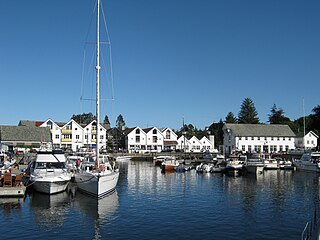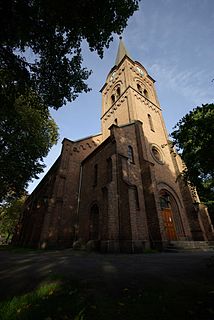Related Research Articles

Austevoll is a municipality and an archipelago in Vestland county, Norway. It is located in the traditional district of Midthordland in Western Norway. The administrative centre is the village of Storebø on the island of Huftarøy. Other villages include Årland, Austevollshella, Bakkasund, Bekkjarvik, Birkeland, Haukanes, Husavik, Kolbeinsvik, Otterå, Våge, and Vinnes.

Grip is an archipelago and deserted fishing village in Møre og Romsdal county, Norway. It is located about 14 km (9 mi) northwest of the town of Kristiansund in the Norwegian Sea. The Grip Lighthouse, one of the tallest lighthouses in Norway, is located on one of the islands of Grip. The historic Grip Stave Church is located on the island of Gripholmen. From 1897 until 1964, the islands were part of Grip Municipality, but the islands were merged into Kristiansund Municipality in 1964.

Haakon Shetelig was a Norwegian archaeologist, historian and museum director. He was a pioneer in archaeology known for his study of art from the Viking era in Norway. He is most frequently associated with his work on the Oseberg ship (Osebergfunnet) near Tønsberg, Norway.

The fishing industry in Scotland comprises a significant proportion of the United Kingdom fishing industry. A recent inquiry by the Royal Society of Edinburgh found fishing to be of much greater social, economic and cultural importance to Scotland than it is relative to the rest of the UK. Scotland has just 8.4 per cent of the UK population but lands at its ports over 60 per cent of the total catch in the UK.
Events in the year 1906 in Norway.

Nils Christian Tønsberg was a Norwegian publisher and author. Christian Tønsberg became one of the larger Norwegian publishers and was best known for illustrated books about Norway.
Carl Harald Beyer was a Norwegian literary historian and lecturer, literary critic, textbook writer and professor of European literature at the University of Bergen.
Conrad Vogt-Svendsen was a Norwegian priest. He was assistant seamen's priest in Hamburg during Second World War, helped with the White Buses operation in 1945, and was later main priest for the deaf in Norway.

Daniel Smith Thrap was a Norwegian priest, historian and author.
Sverre Steen was a Norwegian historian and professor at the University of Oslo from 1938 to 1965. He served as president of the Norwegian Historical Association from 1936 to 1947
Anders Beer was a Norwegian ship-owner and tanner.
Mons Andreas Andersen Kårbø was a Norwegian leader of fishing organizations and politician for the Liberal Party. He played a central role in postwar academic and economic organization of the Norwegian fishing industry.
Einar Hoffstad was a Norwegian encyclopedist, newspaper editor, writer and economist. He remains best known as the editor of the encyclopedia Merkantilt biografisk leksikon and the business periodical Farmand. Although initially a classic liberal, Hoffstad embraced fascism and collectivism at the beginning of the Second World War.

Vestlandsk or Vestlandske dialekter is a collective term for the dialects that are spoken on the coast of western Norway in the area ranging from Romsdal in the north to Agder in the south. These dialects can furthermore be split into north-western dialects (Nordvestlandske dialekter), south-western dialects and southern dialects.

The fishing industry in Denmark operates around the coastline, from western Jutland to Bornholm. While the overall contribution of the fisheries sector to the country's economy is only about 0.5 percent, Denmark is ranked fifth in the world in exports of fish and fish products. Approximately 20,000 Danish people are employed in fishing, aquaculture, and related industries.
The A. C. Houen Grant was a grant that awarded funds to Norwegian artists. The grant was established by the Norwegian businessman and philanthropist Anton Christian Houen (1823–1894). There is some uncertainty about some of the awards that were associated with this fund, including whether the painter Astri Welhaven Heiberg received the grant in the 1920s.

Grip is a former municipality in Møre og Romsdal county, Norway. With a land area of only 0.48 square kilometres and a population of 104, Grip was the smallest municipality in Norway during its existence from 1897 until it merged with Kristiansund in 1964. Grip municipality included all the islands in the Grip archipelago. The administrative centre of the municipality was the one fishing village in the municipality, known as Gripholmen, where the historic Grip Stave Church is located.

Finn Devold was a Norwegian Arctic explorer, marine biologist and meteorologist. His father was parish priest Harald Ophus Devold. Together with his brother Hallvard Devold, Finn shared the same interest in the Arctic areas and in the expansion of Norwegian sovereignty in Greenland.
Events in the year 2020 in Norway.